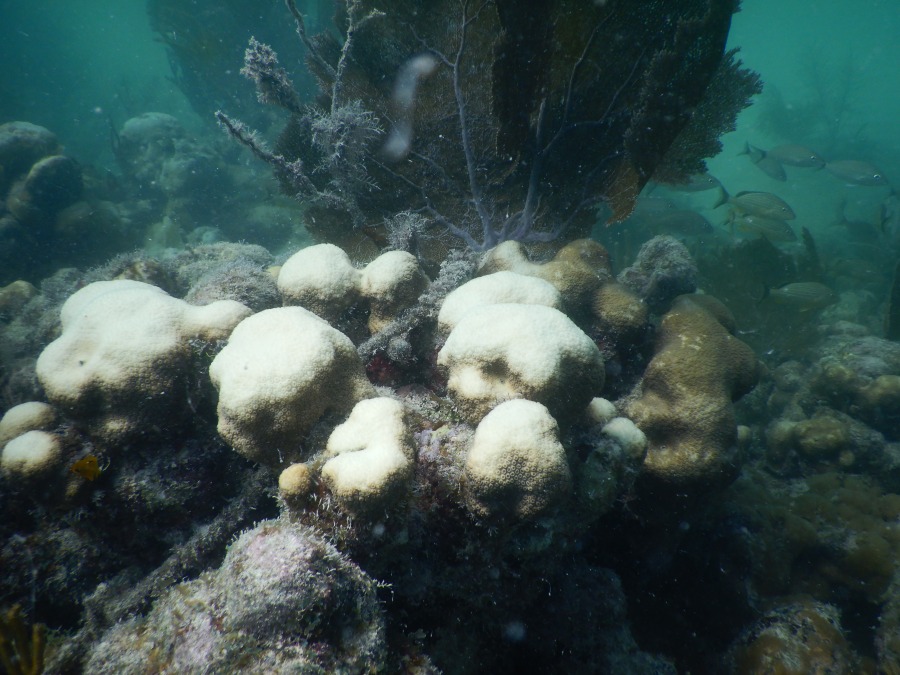TAMPA. Fla. (WFLA) — Florida’s reef tract, the third largest in the world, has been in big trouble for many years from coral bleaching, stony coral tissue loss disease and severe storms.
Ninety-five percent of the coral cover has already been lost and right now, a massive coral bleaching event is underway in South Florida. The long-term prognosis for tropical coral reefs is bleak as oceans continue to warm. Coral bleaching events are increasing around the globe and scientists say that the majority of reefs could vanish by mid-century.
South Florida’s event is just the latest. While this is more bad news for the battered South Florida reef system, scientists say they’ve just observed evidence for hope. During this event, they observed some resilient coral on the reefs they have been restoring off Miami-Dade County.
WFLA’s Chief Meteorologist and Climate Specialist Jeff Berardelli spoke to University of Miami researcher Dalton Hesley about the current bleaching event and if the work they are doing on the reefs is enough to save them. “This year it became apparent that this was a much more severe event and that we were seeing a wider range of coral species experiencing ongoing bleaching,” Hesley told Berardelli. Image of ongoing South Florida coral bleaching event from Dalton Hesley Hesley was the first to discover a massive coral bleaching event – still ongoing – along the reefs from Stuart to Key West.
It’s been six years since the last big bleaching event, but as seen in the below animation, waters were warmer – for longer – this August and September. Sea Surface Temperature Departure from Normal /NOAA Coral Reef Watch “Corals are very sensitive and they need a very specific thermal range and so if you breach that thermal range, even by ½ a degree over a sustained period of time it can cause enough stress to cause these corals to experience a bleaching event,” Hesley explains. Image taken recently of coral bleaching off Miami/ Dalton Hesley.
When water temperatures exceed around 87 degrees for too long coral stresses. It turns white, and if that stress lasts long enough the coral can die. But this year, early cold fronts and, ironically, Hurricane Ian may have helped avert disaster.
In the animation above you can see some cooling take place at the very end of September as Ian passes by. And Florida’s dwindling coral population needs all the help it can get. So, for years, the University of Miami Rosenstiel School has been using cutting-edge science to grow coral in the lab and replant it in the wild.
One key to weathering these stressors is creating a diversified community of coral, therefore if the reef succumbs to bleaching or disease, some of the more hardy coral can weather the proverbial storm. Hesley says there’s evidence from his recent dives that their methods are working. “We had one restoration site that had over 100 genotypes and at that site, it was clear that there was a great degree of variability in the corals that were bleaching,” explained Hesley, “So maximizing our restorations diversity increases the overall likelihood of success long term and so this real-world case study kind of exemplified that.
” But humans can only do so much. It’s David battling the Goliath of global warming. Berardelli: “Are water temps warming up too fast for us as humans to be able to replant these corals and be successful at restoring these coral reefs, or is there truly hope here?” Hesley: “There is hope, but, ocean temps are warming too fast, ocean acidification is happening to quickly, storms are intensifying, and so coral restoration is not enough to restore the future of our coral reefs.
“.
From: wfla
URL: https://www.wfla.com/weather/climate-classroom/severe-coral-bleaching-event-in-south-florida-can-coral-reefs-be-saved/
